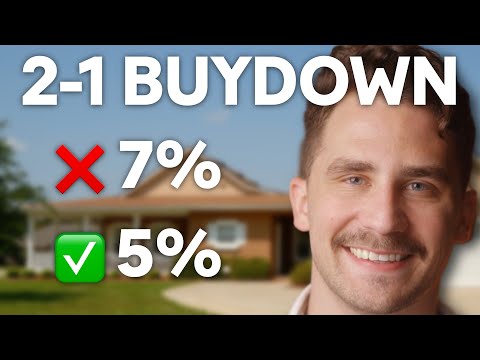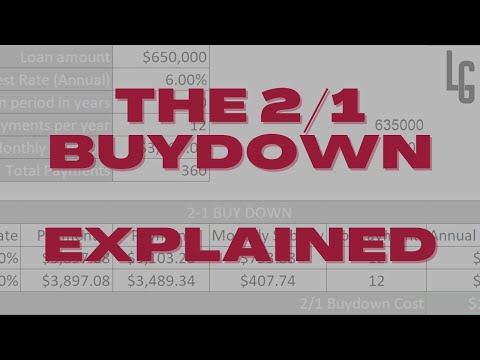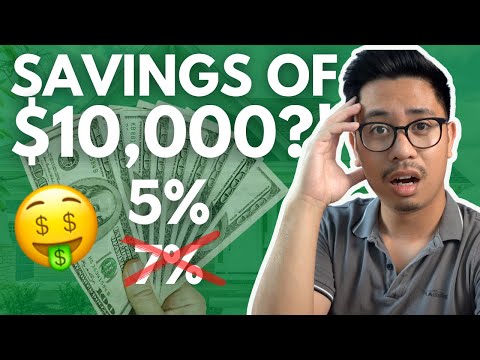In the labyrinthine world of home mortgages, one often overlooked pathway is the 2-1 buydown. This kind of loan is a special breed, offering unique affordability benefits unmatched by traditional mortgage methods. It’s about time this unsung hero of the mortgage world got its due credit!
Understanding the Basics of 2-1 Buydown Mortgages
In essence, a 2-1 buydown is akin to a mortgage price markdown. It’s a financial arrangement that reduces the interest rate of a mortgage for the first two years. By doing so, it makes initial home mortgage payments more affordable. The buydown rate typically drops by two percentage points the first year and one point the second year, hence the term ‘2-1 buydown’.
Now, how does this wonder of a mortgage compare with others? Traditional term and adjustable-rate mortgages offer a van set interest rate throughout the life of the loan or a rate that fluctuates with market conditions, respectively. Unlike these, the 2-1 buydown offers a “sweetener” of lower interest during the initial years, softening the financial blow for new homeowners.
Delving deeper into the ‘why,’ the 2-1 buydown could be the lifeboat many struggling home aspirants need. It creates a window of affordability, allowing would-be homeowners to gain a foothold in their new property. That’s really the game-changer aspect of the 2-1 buydown. You can explore more about this phenomenon by looking into How much To buy down interest rate.

The Mechanism Behind 2-1 Buydown Mortgages
Wondering how this beaut of a mortgage works? Easy-peasy! In a 2-1 buydown, the seller extends a credit to the buyer, which is then invested in an escrow account. The funds in this account are used to “buy down” the interest rate for the initial two years. Imagine it as the seller offering you a generous discount used to lighten your early mortgage load.
The specifics of the interest rate revisions vary but essentially reflect the titular ‘2-1’ rule. The first year’s rate is often two percentage points below the standard, transitioning to a single point below in year two. From then onwards, you’ll be coasting on the permanent rate stated in your mortgage terms.

| Aspect | Description |
|---|---|
| What is a 2-1 Buydown? | A mortgage financing option that lowers the interest rate for the first two years before it rises to a regular, permanent rate. |
| How it Works | The seller offers credit to the buyer/borrower. The credit is put into an escrow account which is then used to buy down the interest rate for the first two years. |
| Rate Reduction | A typical 2-1 buydown offers a rate that’s two percentage points lower in the first year and one point lower in the second year. |
| Benefit | A 2-1 buydown allows homebuyers to save money on their mortgage payments in the short term while still enjoying the benefits of a fixed-rate mortgage in the long term. |
| Financial Consideration | For homebuyers planning to stay in the home long-term, a 2-1 buydown may count as financially beneficial. If the buyer expects interest rates to drop, refinancing might be a better option. |
| Refinance Option | Refinancing a 2-1 buydown mortgage can potentially save more on monthly payments. |
| Ideal For | This is an ideal solution for homebuyers seeking to make lower payments in the short term due to budget constraints, but are confident of making higher payments in the future. |
Benefits of Choosing a 2-1 Buydown Mortgage
Alright, folks, let’s shift into high gear and talk about the winning hand of attributes the 2-1 buydown is holding. First off, this mortgage plan allows you to enjoy the perks of a lower mortgage payment in the early years, giving you the breathing space to manage the resultant finances more comfortably.
Additionally, the reduced payment amounts can mean hefty interest savings, especially when you compare an interest buydown with standard mortgage payments. It’s almost akin to having your cake and eating it too!
Moreover, by making mortgage ownership more attainable, the 2-1 buydown can help you build home equity sooner. While you’re enjoying the lower interest rate, your property could be appreciating in value, resulting in enhanced home equity.

Understanding the Potential Drawbacks of 2-1 Buydown Mortgages
Like any financial option, 2-1 buydowns are not without their areas of concern. Future interest rate hikes could be a storm cloud on your mortgage horizon. If rates rise substantially after the initial reduced interest period, you may be left with a larger-than-expected mortgage payment to navigate.
Additionally, the overall cost of the mortgage may end up being higher. It’s a trade-off you’ll want to consider thoroughly. If the comfort of smaller initial payments prevails over the potential long-term cost, then the 2-1 might be the life jacket you need.

Navigating Through the Eligibility Criteria for 2-1 Buydown Mortgages
Before you put on your party puffer jacket and celebrate, there are some hoops to jump through. Every lender will have specific benchmarks, so prospective homeowners must do their homework. Typical prerequisites include proof of income, creditworthiness, and debt-to-income ratios.
Preparation is king! Make sure you’re armed with the necessary documents and are aware of the process. Keep in mind; your potential lender is looking for assurance that you can pay off the loan, and rightly so. You can get a better understanding of criteria with some light reading on How To start a trust fund.

Case Studies: Success Stories with 2-1 Buydown Mortgages
Countless folks have navigated the often-choatic mortgage landscape and emerged victorious, courtesy of the 2-1 buydown. Think of Jane, a single mom who, despite initial financial hurdles, found reprieve in a 2-1 buydown mortgage. Or consider the Martins, a newlywed couple who leveraged this potent financial tool to make their dream home a reality. Each story is a testament to the life-changing power of 2-1 buydown mortgages.

Expert Advice: Key Factors to Consider before Opting for a 2-1 Buydown Mortgage
Like any strategic decision, deciding on a 2-1 buydown requires careful thought. Experts recommend looking at the long-term picture — how long you plan to stay in the home, expectations for future interest rates, and the potential financial burden down the road. You could consider the option to refinance in case interest rates drop at a future date.
Future of 2-1 Buydown Mortgages: An Outlook towards 2030
Speculating about future trends, the 2-1 buydown is likely to remain an appealing option, especially in economically turbulent times. Market shifts, rising property costs, and changes in personal finance trends may affect the popularity of 2-1 buydowns. But with proper planning and careful evaluation, they can continue to offer a credible pathway to affordable homeownership.
A Smarter Path to Home Ownership: Closing Remarks on 2-1 Buydown Mortgages
In the end, the 2-1 buydown stands as a viable contender in the mortgage market, with value propositions that certainly make it worth considering. Take time to assess your situation, financial comfort, risk appetite, and compatibility with the 2-1 model before you decide.
In your path towards homeownership, equip yourself with the right knowledge, be aware of the rules of the game, and step forward with confidence. Remember, a home isn’t just about bricks and mortar; it’s the cornerstone of your financial stability. As you approach this important milestone in life, make the choice that suits you best, for your present, your future, and the roof over your head. Consider consulting the equal housing lender logo and the fair housing logo for more insight into fair and equal housing opportunities in your pursuit of homeownership.
Finally, remember that a 2-1 buydown mortgage could open the door to homeownership and deliver your desired lifestyle on a silver platter. So step on the pedal, and explore the fantastic world of 2-1 buydown mortgages today!
What is a 2-1 rate buydown?
A 2-1 rate buydown, folks, is like a catchy melody you can’t shake off. It’s a method lenders use that temporarily reduces the interest rate of your mortgage during the first two years. The 2-1 bit? That refers to the decrease in rates, with a 2% reduction in the first year and a 1% reduction in the second.
How does a 2-1 buydown work for sellers?
Ah, the seller’s perspective on a 2-1 buydown. It’s a bit like selling lemonade on a hot day: you lower the price, attract more buyers. By offering a 2-1 buydown, sellers can make their property more appealing to potential buyers because they’re essentially lowering the initial costs of the mortgage.
Are mortgage buydowns worth it?
Are mortgage buydowns worth it? Well, as my grandpappy used to say, “It depends on how long you plan to stay put.” If you’re looking to stay in your home a long time, the lower monthly payments might outweigh the upfront costs. But if you’re a rolling stone and move every few years, you might not recoup those upfront costs.
Can you refinance out of a 2-1 buydown?
Planning to refinance out of a 2-1 buydown? Hold your horses. While you can theoretically refinance at any time, bear in mind the possibility of prepayment penalties. Also, refinancing usually comes with costs, so make sure the savings from the lower rate outweigh these fees.
What is a 2-1 buydown for dummies?
A 2-1 buydown for dummies? Picture this: you take a loan, and initially, you pay less interest. The catch is you need to pay an upfront fee to lower your interest rate for two years—2% lower the first year and 1% lower the second.
Is a permanent buydown better than a 2-1 buydown?
Choosing between a 2-1 and a permanent buydown is like picking an apple or an orange. The 2-1 is temporarily sweet with lower initial payments, while a permanent buydown has a flat lower interest rate but could require more money upfront. It’s a matter of preference and financial situation.
Why not to do a 2-1 buydown?
Why not do a 2-1 buydown? Well, sometimes you save more by not chasing the rabbit down the hole. With hefty upfront fees and possible points, it might not be cost-effective if you’re planning to move or refinance within a few years.
What are the disadvantages of a 2-1 buydown?
The disadvantages of a 2-1 buydown are similar to a slightly bitter aftertaste. While you have lower initial payments, the interest rate will eventually rise to a “permanent” rate, which could be higher than market rates. Not to mention, the upfront costs might negate your savings if you move soon.
Who pays for a 2-1 buydown?
Who foots the bill for a 2-1 buydown? More often than not, it’s the buyer or the seller, or divided between them. It’s not set in stone, and it’s a negotiation point like anything else in a real estate deal.
What are the cons of a buydown?
On the downside, buydowns can feel like biting more than you can chew. The upfront costs are significant, and unless you’re staying in the house long enough to benefit from the lower monthly payments, it could be a losing deal.
What are the pros and cons of a 2-1 buydown?
Weighing up the pros and cons of a 2-1 buydown is like balancing on a tightrope. The pros: lower initial monthly payments and easier home affordability. The cons? Potentially higher future rates and steep upfront costs. It’s about balance, buddies.
Is it better to put more money down or buy down interest rate?
Deciding between a larger down payment and buying down the interest rate? It’s a bit like choosing between a burger or fries—you might want both, but which one’s worth more to you? A larger down payment lowers your overall debt, while buying down the rate lowers monthly payments.
Is a 2-1 buydown smart?
A 2-1 buydown smart? Well, mate, it depends on your situation. If you expect your income to increase or plan to stay put long enough to recoup the upfront costs, it could be as clever as a fox.
What happens to unused buydown funds?
Unused buydown funds? They don’t just go off the rails. If your mortgage is sold and there are left-over buydown funds, they’re usually returned to the person who paid for the buydown.
What credit score do you need for a 2-1 buydown?
Pondering over the credit score needed for a 2-1 buydown? Well, it’s not written in the stars, but typically, lenders look for a score of 580 or higher for mortgage loans. Consult with your mortgage professional to get an exact figure.
Who benefits from a 2 1 buydown?
Who profits from a 2-1 buydown? Well, buddy, it’s a win-win kinda deal. The buyer gets lower initial payments, and the seller might sell the property faster if it’s part of the offer.
How does a rate buydown work?
How does a rate buydown work? Imagine you’ve got a magic wand that lowers your mortgage rate—for a fee, of course. That’s essentially how rate buydowns work. You pay upfront to secure a lower interest rate, thus reducing your monthly payments.
What happens to unused buydown funds?
Unused buydown funds go right back into your pocket. If your won’t use the entire set-aside amount by the end of the second year, the remaining funds are typically returned to you or the person who paid for the buydown.
Should I buy down my interest rate?
Should you buy down your interest rate? Look, if you’ve got the cash to spare and plan to keep your mortgage for a good while, then it’s definitely something to consider. It could reduce your monthly payments and save you money in the long run.



